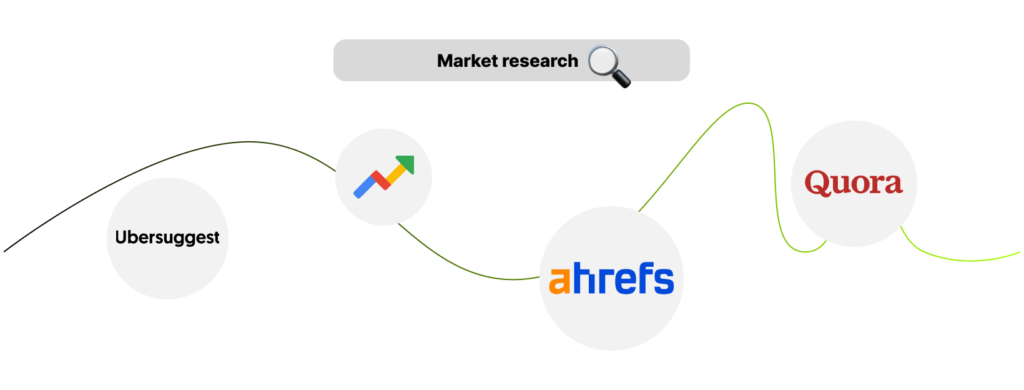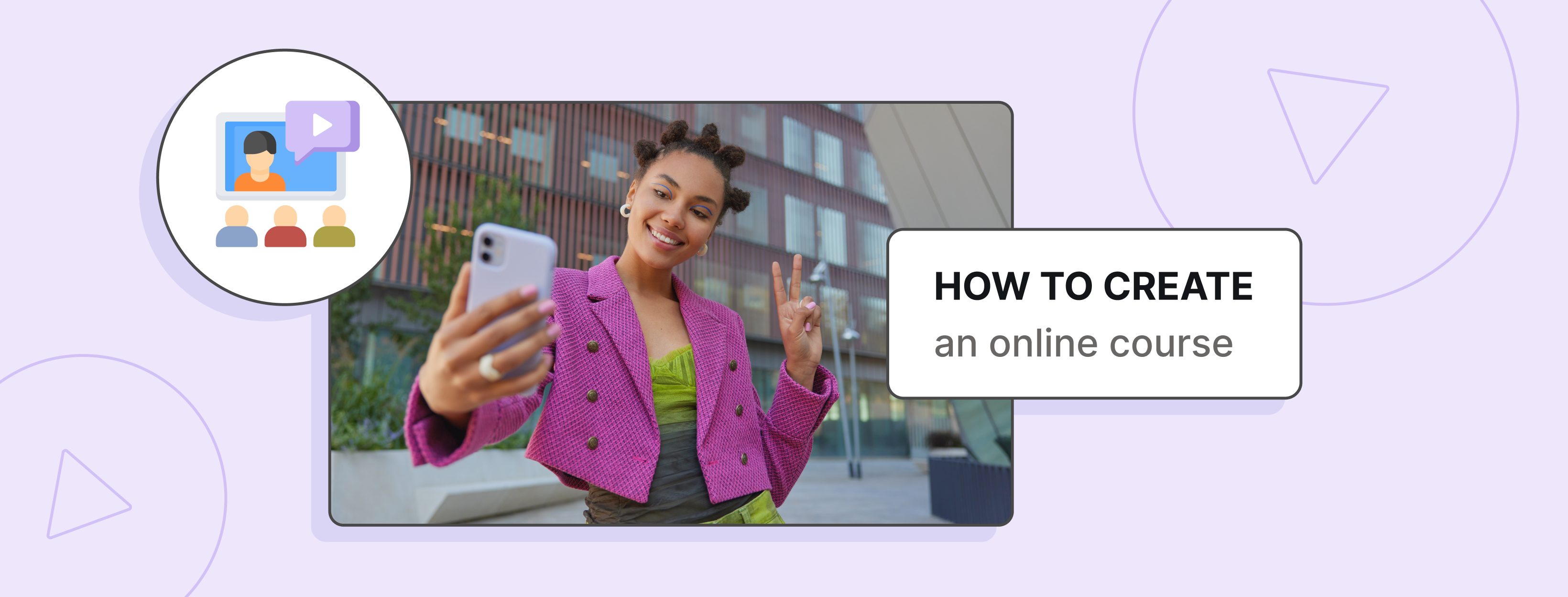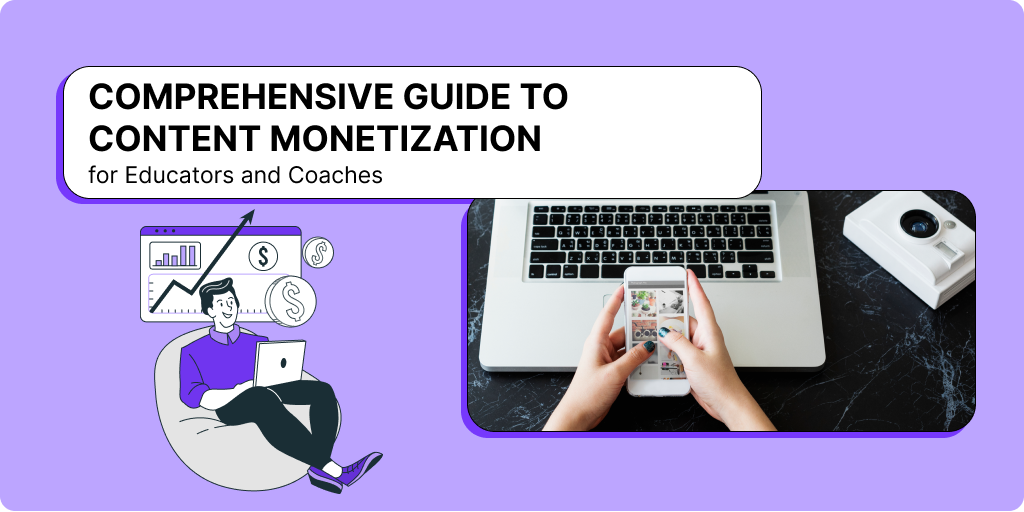Basically, the whole course creation, from zero to publishing, starts with an idea, it’s shaping, realizing, publishing, and then promoting. Sounds pretty easy, doesn’t it? Well in practice this is a bit more complex. Course creation takes time and effort, and most of all it takes commitment. But no need to worry, we are here to guide you carefully through a starting point with useful tips and handpicked advice.
How to select an online course topic
The choice of an online course topic is probably the hardest part: it is here where it all starts. At this stage, creators shape the core idea which later will be realized with a specific medium into a suitable structure.
Expertise and passion
Think, what are you good at and what do you really love? What is this one thing you can talk about all day even for free? The combination of your knowledge and experience is unique, and together they make expertise. It allows you to build a practical course, full of useful information.
But with no passion, it can be quite boring. Remember when you had this exact teacher at school that loved their subject, and that love turned out to be contagious? It even made you excited about each upcoming lesson. With online courses, it’s the same. People will feel your passion even through the screen, and they surely will follow it.
Value
What is the main value of any online course regardless of its type or industry? Well, it would be the transformation. A regular customer expects to receive knowledge, skill, or vision in order to ‘travel’ from where they are now to where they want to be. For example, Anna is making an online course about healthy food. Her objective is to teach her audience how to eat well, but this is a skill, not a transformation. The core desire of her followers is to actually become more attractive, and this is a change Anna can offer.
So, take your time to create value. Select all the skills within your expertise that you can share, write which kind of obstacle they help to overcome, and propose transformation they can bring to learners. We recommend creating a table.
Niche
There are lots of online courses out there even for your topic. Digital content is highly accessible from any place in the world. On the other hand, it’s a huge benefit for you to reach out to potential followers globally. But mind that learners, as they have a big choice, search for something rather specific. For instance, Matthew wants to launch a course about gardening. He’s very good at it, has a ten-year decent experience, and loves it to the moon. But his product can be easily lost among thousands of other gardening classes. So he decides to specify on orchids, how to take care of them outside and indoors.
And this is how Matthew’s online course stands out immediately. In the end, he attracts specific followers, covers their needs fully, and has fewer competitors. Niche down your expertise into a more applicable topic. Just like Matthew did.
How to make a market research
Now it’s time to get into the numbers. Your topic can be a million times good, but you need to verify it statistically. Briefly, don’t rely only on friends’ and relatives’ opinions. Be professional and take it seriously. Research your topic to be sure that there is a demand for it, and not too many competitors. Here are some sources that come in handy.
Market research sources

- Google Trends is a good tool to check what’s popular on the web. Basically, it allows you to see what people search online, how often, and when. You can try the topic you’ve chosen to see how trendy it is.
- Ahrefs analyzes keyword ranking. So, you can type the topic of your online course and check how many there are websites, blog posts, and videos about it.
- Ubersuggest gives data on keywords’ monthly search volume. In simple words, Ubersuggest shows how many online searches are for a certain keyword.
- Quora can be a good tool if you want to rely on opinions rather than just numbers. Put your topic in and you can see how many users have discussions about it, how popular your topic is, and what are the requests.
- Hashtags. The last tip is to go through social media hashtags. Try to find your audience, competitors, and inspiration there.
How to perform a user research
You should know to whom you’re going to sell your online course. Gather as much as you can about your potential audience, so you’ll be able to forge a fitting learning experience. First of all, create an ideal learner avatar. At this step, you sketch the target group. You need to know the pain points of your potential customers and insights caused by transformation. Then, go to the field. Find people on social media that correspond to the portrait of your ideal learner. Study their profiles, and then contact them to conduct small 10 min face-to-face interviews.
You can tell them that you want to create a certain learning experience, and they fit your target audience, so you would appreciate their opinion on the subject. In return, you can offer them a free course when it comes out. Try to talk to at least 10 people, so you’ll have enough information coverage. Having interviews like this will help you with two things: verify if you’ve made a clear target profile, and give you a pull of data for further research.
Afterward, you can create an online questionnaire with Google Forms for example. Using the collected information you’ll be able to ask more precise questions and obtain highly valuable data. With questionnaires, we recommend getting around 30-40 responses.
What are the types of online courses
Basically, there are 3+1 types of online courses. The first three reflect the level of knowledge a curator gives, while the last one relies more on the engagement factor. Let’s go through each type.
Mini online courses
Mini-courses are just great. They are usually made for beginners and take one or two hours to complete. And the creation of mini-courses doesn’t require much, it’s relatively easy to launch them. Which means, they can be a perfect starting point for a creator. The price for minies is either very little or they go for free. You can use them as a marketing tool. For example, to attract new followers with a free learning experience and to upsell later better materials. Or to send a link to a free course by email, and so to grow your personal contact list.
Middle-sized online courses
Middle-sized courses allow a creator to input more knowledge, and share a complex experience. It’s a good way to showcase expertise to an audience with an intermediate level of a subject. Surely, these courses require a longer preparation, especially if they are planned to last a couple of days. They also bring more income and provide a stronger connection with followers.
Professional online courses
Professional courses are at the top of the category. They cost much, but for a good reason. A prof course gives out precise, practical, and unique knowledge that only an expert with years of practice can share. A professional course can take a long time, promising, for example, a new profession afterward. Or it can be short, and solve a very specific problem. In both cases, your audience will be your equals, so better be prepared.
Continuous
Continuous courses are based on subscription. Basically, a learner pays to follow you constantly. In this case, the level of your audience can vary. You can attract beginners for daily inspiration or advanced learners for problem-solving tips. It’s all up to you. The only thing to watch out for is consistency. Remember if people trust to pay you money monthly, they have a full right to expect their quality content on time.

Which content format to choose
Well, depending on the platform where you’ll later publish an online course, you can choose and combine different mediums or formats. The most popular ones are video, image, and text. Each has its own benefits and can bring a huge value to a learner. Here are some tips on how to use and combine these mediums.
Best ways to use content formats
- A strong start. Start your course in a remarkable way. For sure, a video presentation, even a short one, catches attention and builds warm relations with followers. But if showing your face is not your thing, think of something more appealing to you.
- Use them all. Get the best of each format. Explore and experiment with how you could use images even if you offer motivational coaching, and how you could write texts selling stylist service.
- Mix and match. Don’t use the same format constantly. Yes, a course can be very visuallike cooking lessons, for example. We can think about lots of videos and tasty images. But still, try to mix it sometimes with recipe texts.
- Improve. Gather feedback and check statistics. You must know which content format is in favor and when it’s time to change it.
- Do it your way. No matter the rules, if you’re having a strong vision or found your path and it works alright for you, keep it. If you weekly publish love advice based on horoscopes, and the number of subscribers is growing, it better not break the equilibrium with videos.
What is a course outline and how to make one
When you already have a topic for your course, know its type, and understand which formats to use, it’s time to create the outline. A course outline is a structure of a learning path. It includes a topic for each block along with a theme for each lesson. Don’t worry about the exact name when creating an outline, you can shape it later.
Globally, a course outline reflects what you want to put in. There are two main recommendations. First, break the goal down. Moving from abstract to concrete, from theory to practice you can create learning blocks. For example, fitness trainer Florence creates a losing weight program. She makes a block of cardio exercises and fills it with running, swimming, and cycling lessons.
Second, keep the logic. Surround the course goals with equal blocks and lessons in them. In Florence’s program, another block is yoga, with such lessons as ashtanga, vinyasa, and power yoga. But if she decides to include a block with running techniques, it would break the whole structure.
Example of the course outline
Block 1 Cardio exercises:
- running;
- swimming;
- cycling.
Block 2 Yoga:
- ashtanga;
- vinyasa;
- power yoga.
Block 3 Pilates:
- classical pilates;
- mat pilates;
- contemporary pilates.
What is a course outcome and how to make it
Before moving to the technical part, there is one thing left to consider – an online course outcome. Working on outcomes has two purposes. One, you review the original value input or restructure it if needed. Two, you basically create a course description, its introduction.
Main purposes of course outcomes:
- clarify what participants will get after completing a course, which knowledge and skills;
- offer transformational inspiration;
- outline a path of achieving courses goals;
- filter out those who won’t be interested in the training.
Course outcomes are learner-oriented. When you give knowledge, you plant a seed. And it is your task to think out how this seed may grow. Creating the list of outcomes imagine how the value of your expertise can benefit a learner. But don’t be vague. Do the same as with the course topic: niche it down.
Outcomes crafting
Begin with answers to the following list of achievement questions.
- What will learners be able to do, demonstrate or implement after your course?
- What will they understand or analyze?
- What will they become familiar with or fluent with?
- How will their behavior, patterns, or habits change?
- What will they feel after the learning experience?
Ian is making a course about fixing bicycles. He knows that after passing a five-day training, learners will be able to locate and repair simple breakages. They will be introduced to needed equipment and materials. They will recognize breaks in the early stages and generally will feel safer on the road. One more piece of advice. When writing a course description, be not just precise, use verbs. Like this, you highlight the action, just as we did in the section of ‘main purposes of course outcomes’.
But at the same time, avoid words with broad meanings such as ‘learn’, ‘understand’, ‘do’. In fact, they don’t show the real measurable result, but rather confuse the reader. In the example with Ian, verbs make a precise sense: locate, repair, introduce, and recognize. If you need more vocabulary, here are other handy samples: assemble, formulate, determine, establish, construct, craft, uncover, find, conduct, gather, master.
How to film, record, edit an online course
If you’re just a beginner in video content or if you haven’t done it before, trust us, there is not much to worry about. When you have ready your content in logical order, the hardest part is successfully behind you. Now it’s time to make a script, film it, and edit it.

Script
No matter if you’re going to appear in the video or not, you need a script. In a script, you should include the brief plan of the speech, and the sequence of shots. We recommend preparing two separate documents. The sequence order you need to plan and use it between making shots. For instance, if you plan to film a baking lesson, you might have shots of your cooking and close-ups of ingredients. A speech plan is something you would rely on in the process. You might want to have notes or rehearse the talking part before, whatever is comfortable. But avoid reading and memorizing by heart. Human perception immediately distincts ‘not live’ text. In simple words, it kills passion.
Filming
Start with what you have. You don’t need fancy equipment to make a good online course. A smartphone, minimal microphone or even none, and nice lightning will do. When filming, take rather short shots, no longer than 5 min. Later it will be easier to edit or substitute. Also, you can shoot some pieces multiple times and later choose the one you prefer.
Sound recording
The same as with filming, better start small with equipment and grow step-by-step. You can buy a cheap and reliable microphone. There are lots of options for bloggers and creators, those mics are not extremely advanced technically, as for musicians for example, but they do a good job of catching the voice. When recording the sound, place a device on a flat surface, in the direction of your mouth. At the same time, don’t put your hands on the same surface to avoid vibrations and noises. Test your microphone before you record. And again, make multiple copies.
Editing
When it comes to editing, keep it simple and easy to follow. But still, you can unleash your creativity and give your special touch to the content. No matter what you choose, remember your target audience and their learning needs.

Where to set up an online school
There are lots of platforms out there. We recommend Trible as an online course platform, it allows building a branded application within hours and with no code at all. Trible is tailored for creators that want full control over the platform, conversion, and monetization. The builder also offers website creation. Trible has all the tools you need to create an online course. You can upload videos, images, and texts; launch separate lessons and group them into sequences; design the look and structure the course.
When it comes to monetization, there are two options: one-time payment and subscription. With a single purchase, creators can heat up the value of a lesson, and with a subscription, they can rely on followers and plan the income. Building an application with Trible is quite easy. You need to register first, and then start creating with a drag-and-drop function. When it’s ready we will gladly publish it for you on Apple Store and Google Play. Follow this link to begin the journey.
Which pricing plan to choose
There are basically three price models a creator can choose from when selling online courses: single payment, subscription, and free cost. Each of these systems can be very attractive both for a customer and you. Let’s see why.
A single payment is a perfect option when you want to sell something exclusive and highly valuable like a professional course. An advanced audience is ready to pay here and now for precious expertise. Single payment also suits new followers that might have tried your free content or not, but they want a bit more just to get a better understanding of the full value. In any case, you benefit from having a big amount from each participant.
A subscription model is ideal to keep your followers. The price for a frequent content flow would be way less than for a single course, but you could rely monthly on your learners, and predict the income. Free courses don’t give you money immediately, but they build a community. You can attract new followers, get their contacts, showcase the value, and afterward upsell. But don’t make lots of free courses as it would look rather suspicious to give away precious knowledge.
How to market an online course
The last step in building courses is promotion, both at the course launching and during its lifecycle. The main advice is to use as many sources as you can. Here we have gathered the most useful marketing tips for you to promote the learning experience.
Marketing tips
- Website. Put advertising of the online course on your website, create blog posts about it, and graphical banners on the home page.
- Social media. Promote courses on your social media profiles, especially on the relevant for your target group platforms.
- Email. Create mailing lists, keep in touch with potential customers, and include the course link in your email signature.
- Paid advertising. Choose the platform and go for it. It can be Instagram reels, Google Ads, YouTube banners, and many more.
- Influencers. Get influencers to talk about your online course. You can either pay them or offer your learning experience for free.
- Cross-promotion. Create YouTube channels, launch podcasts, and make a Facebook page. In simple words, expand and promote between the platforms.
- Testimonials. Collect user feedback and share it.
- Discounts and bundles. Make it cheaper and attract new followers, upsell afterward.
- Forums and blogs. Create discussions about your topic and leave comments under relevant posts. This way you initiate communication and set yourself as an expert.
- Languages. Translate your online course to foreign languages and attract a new audience.
Motivational kick
It’s normal to feel overwhelmed with all you need to do for online course creation. After all, it’s a big input. But don’t let it stop you. Better make it small, by baby steps, and certainly not perfect, but complete the task. If you’ll pass from the dreaming stage to the realization – this is already a success. It takes just once to become it. One course makes you a creator.
 Putting on a Show: Trible's Guide to Crafting Outstanding PowerPoint Presentations
Putting on a Show: Trible's Guide to Crafting Outstanding PowerPoint Presentations








